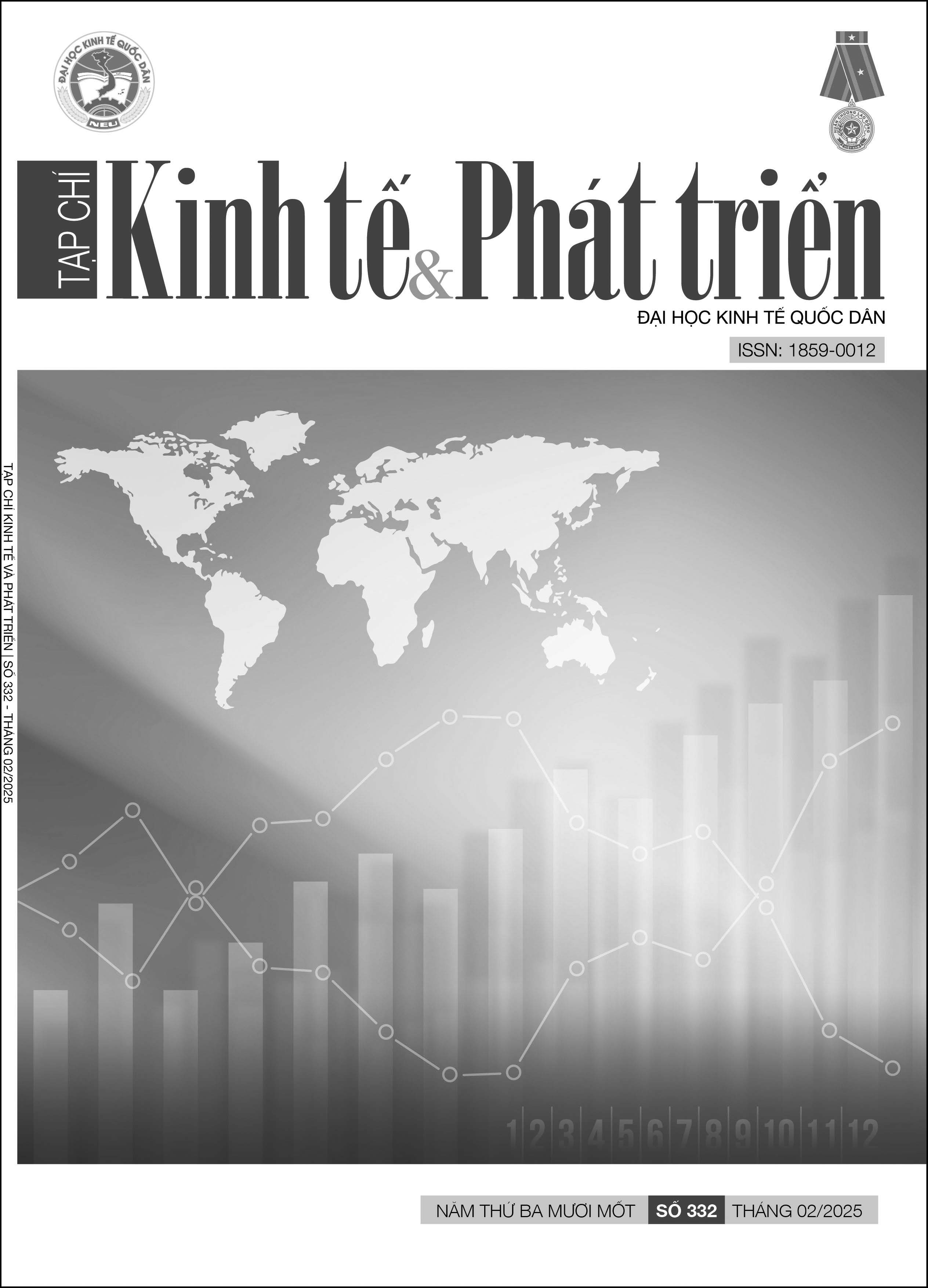Lan toả rủi ro đuôi của thị trường tiền điện tử
DOI:
https://doi.org/10.33301/JED.VI.1850Từ khóa:
Thị trường tiền điện tử, lan truyền rủi ro đuôi, QVAR, CAViaRTóm tắt
Nghiên cứu được thực hiện nhằm mục tiêu đánh giá hiệu ứng lan truyền rủi ro đuôi giữa tám loại tiền điện tử (Bitcoin, Ethereum, Tether, Binance, USD Coin, XRP, Dogecoin và Cardano) trong giai đoạn 2018 – 2024. Để làm rõ vấn đề này, nghiên cứu sử dụng mô hình rủi ro tự hồi quy có điều kiện (Conditional Autoregressive Value-at-Risk: CAViaR) do Engle & Mangenelli (2004) đề xuất để ước tính giá trị rủi ro đuôi bất đối xứng. Sau đó, mô hình chỉ số lan tỏa theo phân vị do Chatziantoniou & cộng sự (2021) đề xuất được sử dụng để xác định hiệu ứng lan truyền rủi ro đuôi dưới các điều kiện thị trường thay đổi (rủi ro cao, trung bình và thấp). Kết quả phân tích thực nghiệm cho thấy sự lan truyền rủi ro đuôi đáng kể tại thị trường tiền điện ảo trong điều kiện thị trường có rủi ro cao. Ngoài ra, vai trò nhận và lan truyền rủi ro đuôi của từng loại tiền điện ảo thay đổi rõ ràng theo từng giai đoạn cụ thể: (1) Trước COVID, (2) Trong COVID-19 và (3) Chiến tranh Nga–Ukraine. Kết quả là kênh thông tin quan trọng cho nhà đầu tư và nhà làm chính sách.
Tài liệu tham khảo
Abakah, E. J. A., Brahim, M., Carlotti, J. E., Tiwari, A. K., & Mensi, W. (2024), ‘Extreme downside risk connectedness and portfolio hedging among the G10 currencies’, International Economics, 178, 100503, DOI: https://doi.org/10.1016/j.inteco.2024.100503.
Abdullah, M., Abakah, E. J. A., Ullah, G. W., Tiwari, A. K., & Khan, I. (2023), ‘Tail risk contagion across electricity markets in crisis periods’, Energy Economics, 127, 107100, DOI: https://doi.org/10.1016/j.eneco.2023.107100.
Ali, S., Moussa, F., & Youssef, M. (2023), ‘Connectedness between cryptocurrencies using high-frequency data: A novel insight from the Silicon Valley Banks collapse’, Finance Research Letters, 58, 104352, DOI: https://doi.org/10.1016/j.frl.2023.104352.
Belguith, R., Manzli, Y. S., Bejaoui, A., & Jeribi, A. (2024), ‘Can gold-backed cryptocurrencies have dynamic hedging and safe-haven abilities against DeFi and NFT assets?’, Digital Business, 4(2), 100077, DOI: https://doi.org/10.1016/j.digbus.2024.100077.
Bouri, E., Molnár, P., Azzi, G., Roubaud, D., & Hagfors, L. I. (2017), ‘On the hedge and safe haven properties of Bitcoin: Is it really more than a diversifier?’, Finance Research Letters, 20, 192-198, DOI: https://doi.org/10.1016/j.frl.2016.09.025.
Chatziantoniou, I., Gabauer, D., & Stenfors, A. (2021), ‘Interest rate swaps and the transmission mechanism of monetary policy: A quantile connectedness approach’, Economics Letters, 204, 109891, DOI: https://doi.org/10.1016/j.econlet.2021.109891.
Diebold, F. X., & Yilmaz, K. (2012), ‘Better to give than to receive: Predictive directional measurement of volatility spillovers’, International Journal of forecastingForecasting, 28(1), 57-66.
Engle, R.F., & Manganelli, S. (2004), ‘CAViaR: Conditional autoregressive value at risk by regression quantiles’, Journal of Business & Economic Statistics, 22(4), 367-381.
Esparcia, C., Escribano, A., & Jareño, F. (2024), ‘Assessing the crypto market stability after the FTX collapse: A study of high frequency volatility and connectedness’, International Review of Financial Analysis, 94, 103287, DOI: https://doi.org/10.1016/j.irfa.2024.103287.
Jiménez, I., Mora-Valencia, A., & Perote, J. (2024), ‘Bitcoin halving and the integration of cryptocurrency and forex markets: An analysis of the higher-order moment spillovers’, International Review of Economics & Finance, 92, 302-315.
Katsiampa, P., Yarovaya, L., & Zięba, D. (2022), ‘High-frequency connectedness between Bitcoin and other top-traded crypto assets during the COVID-19 crisis’, Journal of International Financial Markets, Institutions and Money, 79, 101578, DOI: https://doi.org/10.1016/j.intfin.2022.101578.
Kumar, S., Patel, R., Iqbal, N., & Gubareva, M. (2023), ‘Interconnectivity among cryptocurrencies, NFTs, and DeFi: evidence from the Russia-Ukraine conflict’, The North American Journal of Economics and Finance, 68, 101983, DOI: https://doi.org/10.1016/j.najef.2023.101983.
Kyriazis, N., Papadamou, S., Tzeremes, P., & Corbet, S. (2024), ‘Quantifying spillovers and connectedness among commodities and cryptocurrencies: Evidence from a Quantile-VAR analysis’, Journal of Commodity Markets, 33, 100385, DOI: https://doi.org/10.1016/j.jcomm.2024.100385.
Lang, C., Hu, Y., Corbet, S., & Hou, Y.G. (2024), ‘Tail risk connectedness in G7 stock markets: Understanding the impact of COVID-19 and related variants’, Journal of Behavioral and Experimental Finance, 41, 100889, DOI: https://doi.org/10.1016/j.jbef.2024.100889.
Maghyereh, A., & Ziadat, S.A. (2024), ‘Pattern and determinants of tail-risk transmission between cryptocurrency markets: new evidence from recent crisis episodes’, Financial Innovation, 10(1), 77, DOI: https://doi.org/10.1186/s40854-023-00592-1.
Mgadmi, N., Sadraoui, T., Alkaabi, W., & Abidi, A. (2023), ‘The interconnectedness of stock indices and cryptocurrencies during the Russia-Ukraine war’, Journal of Economic Criminology, 2, 100039. DOI: https://doi.org/10.1016/j.jeconc.2023.100039.
Nguyen, A.P.N., Mai, T.T., Bezbradica, M., & Crane, M. (2023), ‘Volatility and returns connectedness in cryptocurrency markets: Insights from graph-based methods’, Physica A: Statistical Mechanics and its Applications, 632, 129349, DOI: https://doi.org/10.1016/j.physa.2023.129349.
Polat, O., & Kabakçı Günay, E. (2021), ‘Cryptocurrency connectedness nexus the COVID-19 pandemic: evidence from time-frequency domains’, Studies in Economics and Finance, 38(5), 946-963. DOI: https://doi.org/10.1108/SEF-01-2021-0011.
Rahman, M.R., Naeem, M.A., Yarovaya, L., & Mohapatra, S. (2024), ‘Unravelling systemic risk commonality across cryptocurrency groups’, Finance Research Letters, 105633, DOI: https://doi.org/10.1016/j.frl.2024.105633.
Ullah, M., Sohag, K., & Haddad, H. (2024), ‘Comparative investment analysis between crypto and conventional financial assets amid heightened geopolitical risk’, Heliyon, 10(9), DOI: https://doi.org/10.1016/j.heliyon.2024.e30558.
Umar, Z., Jareño, F., & de la O González, M. (2021), ‘The impact of COVID-19-related media coverage on the return and volatility connectedness of cryptocurrencies and fiat currencies’, Technological Forecasting and Social Change, 172, 121025, DOI: https://doi.org/10.1016/j.techfore.2021.121025.
Xu, Q., Zhang, Y., & Zhang, Z. (2021), ‘Tail-risk spillovers in cryptocurrency markets’, Finance Research Letters, 38, 101453, DOI: https://doi.org/10.1016/j.frl.2020.101453.
Yousaf, I., Pham, L., & Goodell, J.W. (2024), ‘Dynamic spillovers between leading cryptocurrencies and derivatives tokens: Insights from a quantile VAR approach’, International Review of Financial Analysis, 94, 103156, DOI: https://doi.org/10.1016/j.irfa.2024.103156.
Zhang, Y., Zhou, L., Li, Y., & Liu, F. (2023), ‘Higher-order moment nexus between the US Dollar, crude oil, gold, and bitcoin’, The North American Journal of Economics and Finance, 68, 101998, DOI: https://doi.org/10.1016/j.najef.2023.101998.





